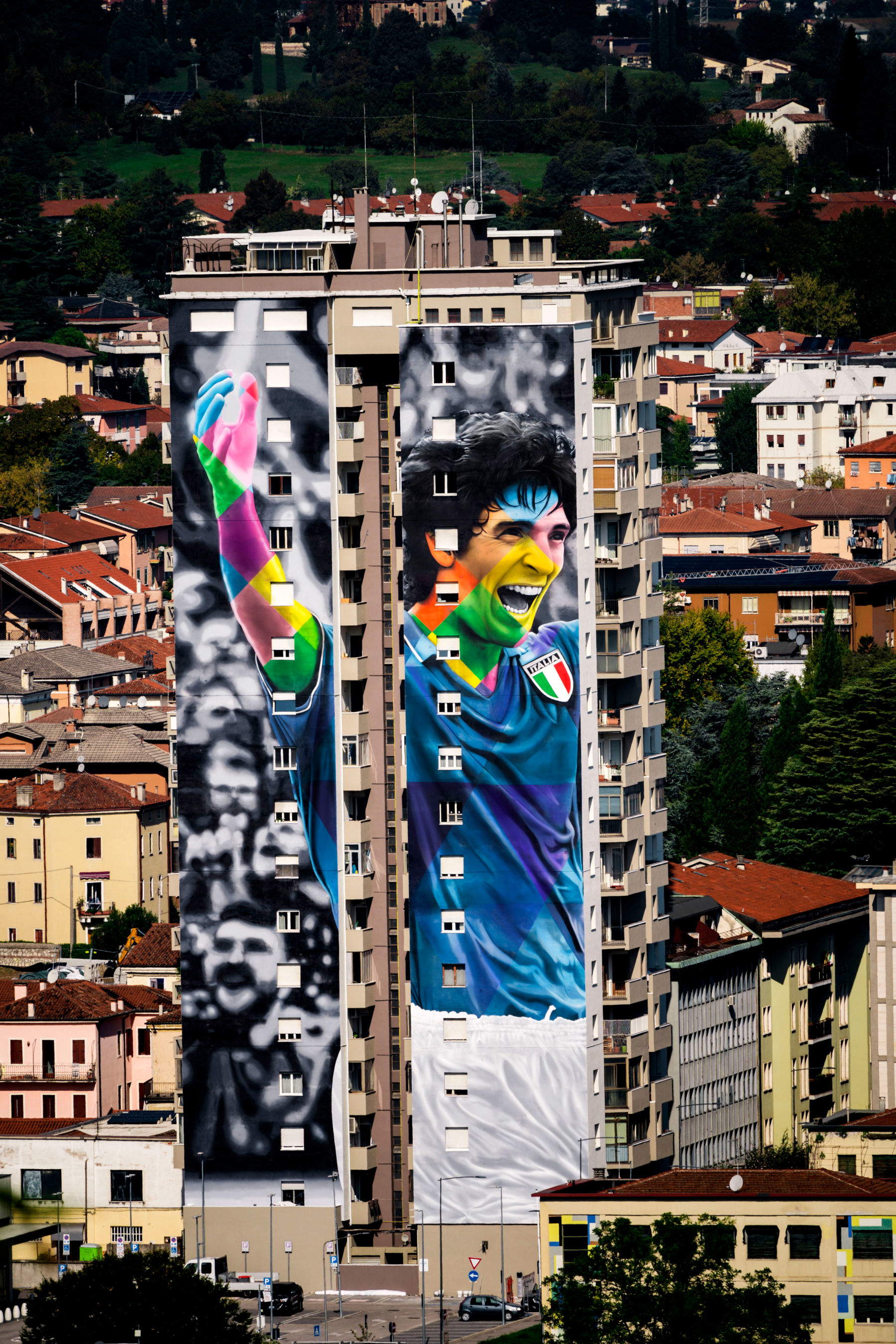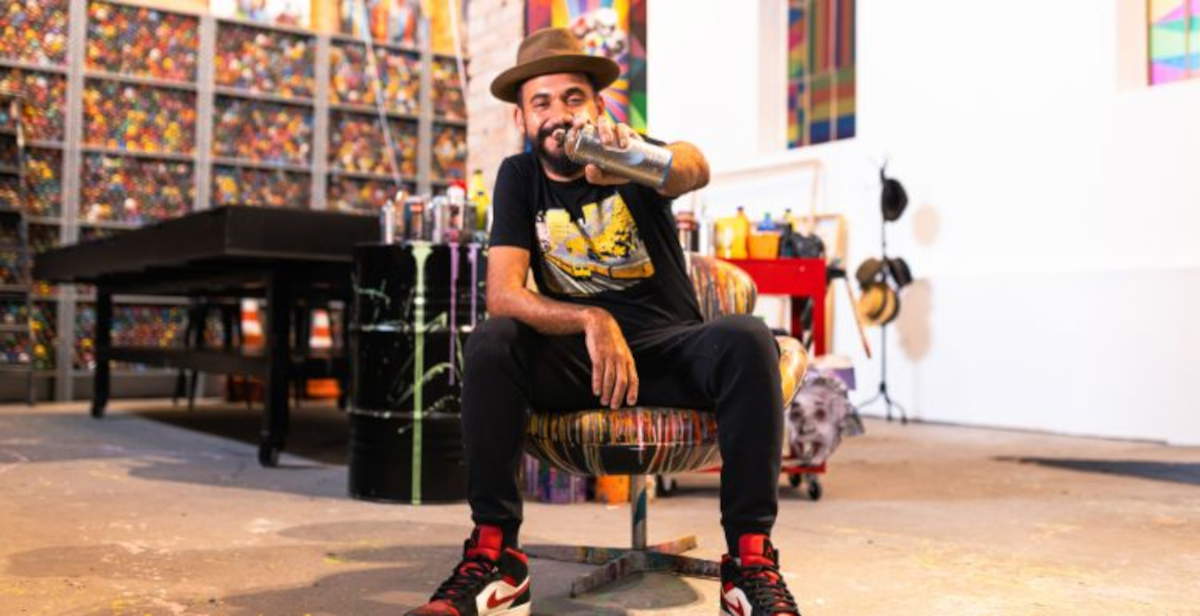Brazilian artist Eduardo Kobra (São Paulo, Brazil, 1975) makes his Venice debut with a permanent project that interweaves historical memory, climate emergency and urban visual language. On June 7, he inaugurates Arte Água Alta, an 80-square-meter mural intervention that will occupy nine openings on a historic building within Spazio Thetis, an exhibition complex nestled in the former industrial area of the North Arsenal. The work is conceived as an alert message, a visual narrative that addresses the problem of rising seas and ocean pollution, elements that have long threatened the environmental stability and future of coastal cities. Venice, with its hydrogeological fragility and the recurring phenomenon of high water, emblematically represents this precarious condition.
“I take this opportunity to convey the urgent message that humanity must take better care of the planet. I am referring to the pollution of the oceans, which are turning into seas of plastic, and the increasing frequency of flooding,” Kobra argues.
“Kobra turns art into a tool to communicate a humanistic philosophy: a united world without borders, connected by an awareness of beauty and its fragility,” adds the project’s curator, artist Nicolas Fiedler. “If this is not the most appropriate vision to bring to life the first permanent mural on an island like Venice, then what might be? During this period of the Architecture Biennale, the greatness of the initiative lies not only in the scale of the installation, but also in its emphasis on the ecological and social context,” the curator points out.
Kobra, known for his monumental murals that often convey social and civic messages, intervenes on a surface that originally housed windows. Now those architectural voids become the support for a visual narrative composed of nine elements: each depicts a celebrated sculpture of Venetian heritage, projected into a flooded future. The installation, which fits into the urban landscape without changing its structure, dialogues with the environment and with the Venice Biennale, of which Spazio Thetis is a partner and exhibition venue. The project is distinguished by the careful selection of subjects, chosen from among the most significant symbols of public sculpture in the city. Among the figures represented by Kobra are Tiziano Aspetti’sAtlas of the World, Antonio Rizzo’sAdam, Bartolomeo Colleoniscolpita’s Equestrian Statueby Andrea del Verrocchio, Antonio Dal Zòtto ’s Monument to Daniele Manin, and Luigi Borro’s Monument to Carlo Goldoni. Completing the composition are the Tetrarchs, St. Mark, the Lion of St. Mark and the statue of Sior Antonio Rioba, all works by unknown authors. Kobra immerses each figure in a flooded scenario, in which water submerges or threatens the base of the monuments, turning the work into a tangible warning. The work has been described by art historian Sabrina Badalucco, a scholar at the Brera Academy of Fine Arts, as “a visual cry that, through beauty, invokes ethics and responsibility.”
The result is an installation that aims to stimulate reflection through direct confrontation with art and memory. Venice, a city that helped define the visual and cultural identity of the West, is represented as a reality suspended between historical legacy and imminent risk. The use of sculptural figures, deeply rooted in Venetian topography and imagery, reinforces the sense of urgency conveyed by the work. Spazio Thetis, the site of the intervention, is configured as a coherent setting for a project that addresses the theme of sustainability. Located in the heart of an area once occupied by industrial activities and now regenerated for cultural purposes, the space houses a permanent collection of contemporary open-air art, with a focus on artistic practices that interrogate the relationship between humans, the environment and the urban landscape.
The space is managed by a company active in the field of environmental engineering and sustainable development, an element that strengthens the connection between the art project and the concrete issues of the area. In addition, the visibility of the work will be amplified by the context of the Venice Biennale, which is underway just weeks after the opening. Thanks to its location, the mural will also be easily accessible for international visitors attending the exhibition, particularly via the ferry service that connects the Arsenal to Thetis headquarters. The exhibition will open on Saturday, June 7, starting at 6 p.m. Access to Spazio Thetis, in the Castello Sestiere, is free and permitted Monday through Friday, 10 a.m. to 5:30 p.m. The venue can be reached via ACTV motorboat (lines 4.1, 4.2, 5.1 and 5.2) until 6 p.m. On the occasion of the opening, a continuous ferry service will operate between the Biennale Arsenal and the exhibition venue.


Eduardo Kobra is considered one of the most influential artistic voices internationally for his ability to address environmental issues through street art. In 2022, the artist was appointed World Health Organization Ambassador for a Cleaner Future. In the same year, he unveiled a massive mural in New York City, right in front of the United Nations headquarters, depicting an ecologically healthy planet passed down from father to son-a symbolic image that calls attention to intergenerational responsibility toward the environment. With a career spanning nearly four decades, Kobra has made his mark on all five continents, with hundreds of works spread across Brazil and the rest of the world. Born in 1975 on the outskirts of São Paulo, he began at a very young age painting graffiti on the streets. Over time, he honed a personal and recognizable artistic language of bright colors and bold contrasts, telling stories of iconic characters, historical events and social issues in large-scale murals. International notoriety came with The Kiss, made in New York: from there on, his activity has known no boundaries. In 2018 he created 20 murals simultaneously in the American metropolis, being named “New Yorker of the Year” by a well-known local magazine.
A record-breaking artist-his is the largest graffiti mural in the world-Kobra continues to be involved in ethical and social initiatives. His works on canvas are regularly exhibited in galleries and museums in the United States, Italy, Brazil and elsewhere. In 2023, his life and artistic journey were chronicled in the documentary Kobra Self-Portrait, directed by Lina Chamie, winner of the Grand Prize of Brazilian Cinema. Strongly convinced that art can generate change, he founded the Kobra Institute, with the aim of spreading culture in the suburbs and supporting humanitarian projects in collaboration with responsible and socially committed entities.

 |
| Kobra creates a permanent mural in Venice: a visual alert on the environment |
Warning: the translation into English of the original Italian article was created using automatic tools. We undertake to review all articles, but we do not guarantee the total absence of inaccuracies in the translation due to the program. You can find the original by clicking on the ITA button. If you find any mistake,please contact us.